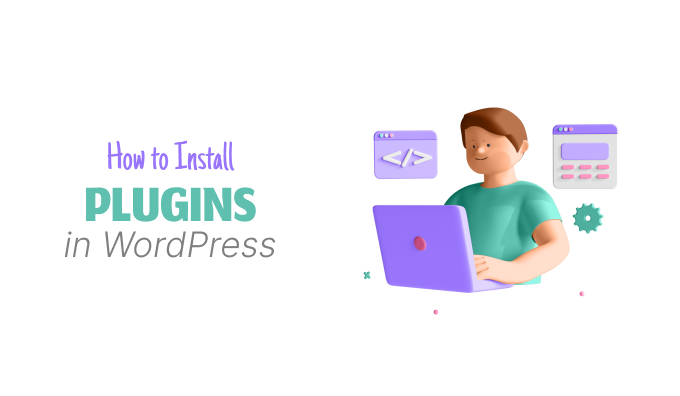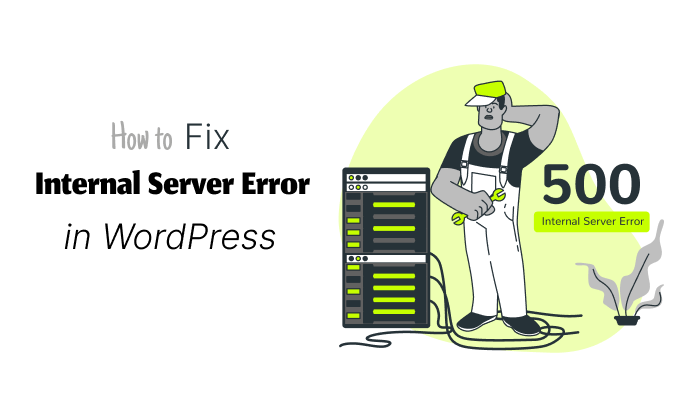
How to Fix the 500 Internal Server Error in WordPress
August 2, 2023
What Is a WordPress Child Theme? Pros, Cons, and More
August 4, 2023Once WordPress is installed, the primary focus for beginners is to understand the process of installing a WordPress plugin.
In basic terms, WordPress plugins function like applications for your WordPress website, enabling you to incorporate various new features such as contact forms, slideshows, shopping carts, and others.
WordPress offers a wide array of both free and paid plugins, and in this comprehensive guide, we will demonstrate the step-by-step procedure of installing a WordPress plugin.
Before You Start
Using WordPress.com restricts your ability to install plugins, and we often receive complaints from users who cannot find the plugins menu in their WordPress dashboard. This limitation is due to the nature of WordPress.com.
On WordPress.com, you are unable to install plugins unless you opt for their business plan. However, if you have a self-hosted WordPress.org website, you can freely install any plugin without any restrictions (check out the differences between self-hosted WordPress.org and WordPress.com).
If you wish to transition from WordPress.com to WordPress.org, we have a detailed tutorial that explains how to make the switch correctly.
Now, let's proceed to explore the process of installing a WordPress plugin on your website.
Install a Plugin using WordPress Plugin Search
The most straightforward method for installing a WordPress plugin involves using the plugin search feature. The only drawback of this approach is that the plugin must be available in the official WordPress plugin directory, which only includes free plugins.
To begin, navigate to the Plugins » Add New page in your WordPress admin area.

Upon accessing the page, a screen resembling the screenshot above will be displayed. Locate the desired plugin either by entering its name or by describing the functionality you require. Following this, a list of results will appear, as shown in the example below:
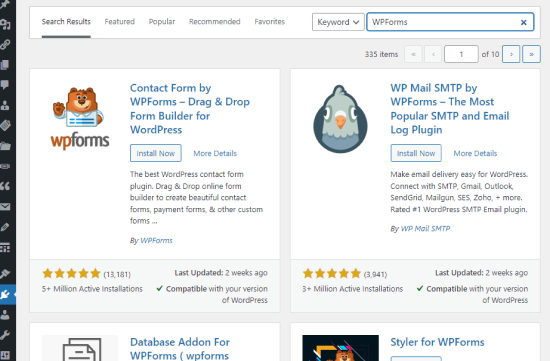
You have the freedom to choose the most suitable plugin for your needs. In our case, as we were searching for WPForms, the top WordPress contact form plugin, we will click on the 'Install Now' button next to it.
WordPress will then proceed to download and install the chosen plugin. Once completed, you will observe that the 'Install Now' button will transform into an 'Activate' button.

You can indeed install a WordPress plugin on your site, but it remains inactive until you activate it. So, proceed by clicking the 'Activate' button to start utilizing the plugin on your WordPress site.
Congratulations! You have now successfully installed your first WordPress plugin.
The subsequent step involves configuring the plugin settings. However, since these settings vary for each plugin, we will not be covering them in this post.
Install a Plugin using the WordPress Admin Plugin Upload
The WordPress plugin directory does not include paid plugins, making it impossible to install them using the primary method.
Therefore, WordPress provides an alternative method called the "upload" option for installing such plugins. In the following steps, we will demonstrate how to use the upload feature in the admin area to install WordPress plugins.
To begin, download the desired plugin from its source, which will typically be in the form of a zip file. Afterward, access the WordPress admin area and navigate to the Plugins » Add New page.
Once there, locate the 'Upload Plugin' button at the top of the page and click on it.
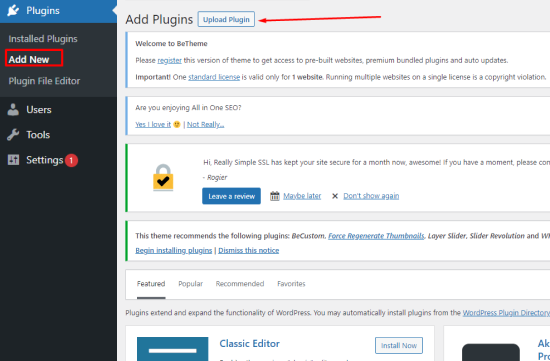
Upon clicking the 'Upload Plugin' button, the plugin upload form will appear. In this form, locate the 'Choose File' button and proceed to select the plugin file you had previously downloaded to your computer.
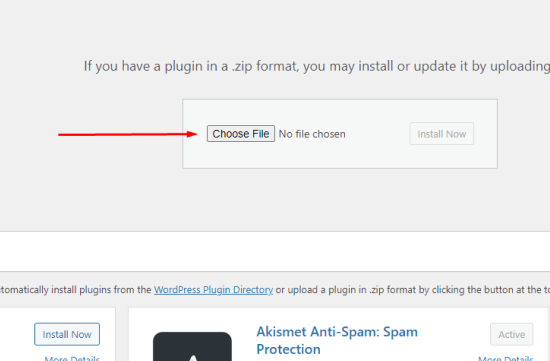
Once you have chosen the file, simply click on the 'Install Now' button.
WordPress will then proceed to upload the plugin file from your computer and install it on your behalf. Upon completion, you will be greeted with a success message like this one.
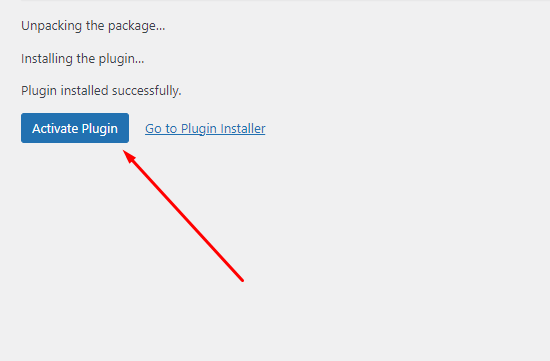
After installation, click on the "Activate Plugin" link to begin using the newly installed plugin.
To tailor the plugin to your requirements, you will need to configure its settings. However, keep in mind that these settings differ for each plugin, and hence, we will not be addressing them in this post.
Manually Install a WordPress Plugin using FTP
In certain rare cases, your WordPress hosting provider might impose file restrictions that limit your ability to install a plugin through the admin area. In such situations, the best approach is to manually install the plugin using FTP (File Transfer Protocol).
However, it's important to note that the FTP method may not be very user-friendly, especially for beginners.
To get started, you'll need to download the plugin's source file, which usually comes in the form of a zip file. Unzip or extract the contents of the zip file on your computer. This will create a new folder with the same name as the plugin.
Next, you'll have to upload this folder manually to your website using an FTP client.
Begin by accessing your host through the FTP manager. If you don't have your FTP username and password, you can obtain them by contacting your WordPress hosting provider.
Open the FTP client on your computer and connect to your website using the provided login credentials from your web host. Once connected, navigate to the /wp-content/plugins/ folder on your website.
Now, upload the folder that you extracted from the zip file to the /wp-content/plugins/ folder on your web server.
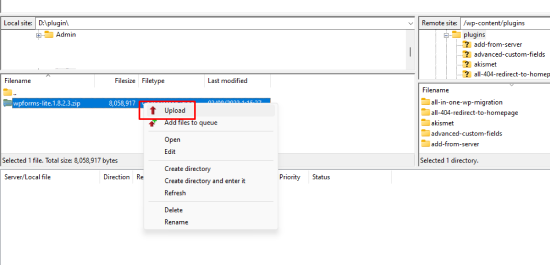
Once the files are uploaded, proceed to the WordPress admin area and click on the Plugins link in the admin menu. Upon doing so, you will find your plugin successfully installed, visible on the plugins page.
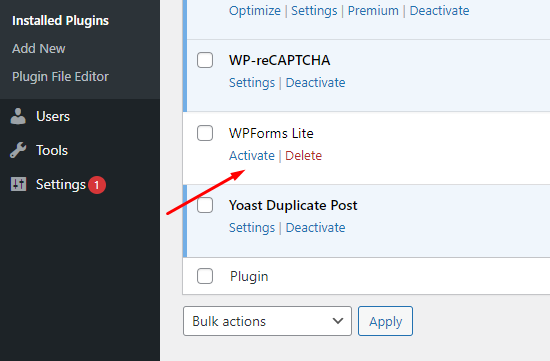
To begin utilizing the plugin, click on the "Activate" link below it.
Once activated, you may need to configure the plugin settings. Keep in mind that each WordPress plugin comes with its own unique settings, which can vary significantly from one plugin to another. Therefore, we won't be providing a general description of these settings here.
FAQs About Installing WordPress Plugins
As beginners, you might have several questions regarding the installation of WordPress plugins. Being the largest WordPress resource site, we have encountered and addressed all of these inquiries.
Let's take a look at some of the most frequently asked questions about installing WordPress plugins.
1. How do I find the best WordPress plugins to install on my website?
The free WordPress plugin directory alone boasts over 55,000 plugins, and there are even more available as premium options. With such a vast selection, beginners might find it challenging to identify the ideal plugin for their specific needs.
To simplify this process, we have curated a comprehensive list of essential WordPress plugins that are commonly required for most WordPress websites.
Moreover, we offer an in-depth tutorial on selecting the best WordPress plugin, guiding you on what factors to consider while searching for a suitable plugin.
2. What is the difference between installed and active plugins?
Within WordPress, you have the liberty to install a plugin without necessarily using it. However, in order to employ a plugin on your website, you must 'Activate' it.
To view your active plugins, navigate to the 'Plugins' page in the WordPress admin area. There, you'll notice the active plugins highlighted with a blue background.
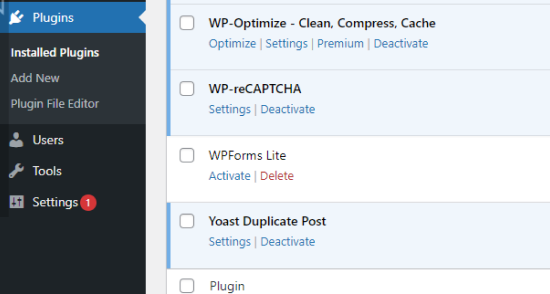
Plugins displayed with a white background are installed on your website but remain inactive.
3. Should I delete inactive plugins?
If a plugin is not in use, it is advisable to remove it from your website. To explore this subject further, refer to our article on the importance of deleting inactive plugins in WordPress.
4. How many plugins I can install in WordPress?
Feel free to install as many WordPress plugins as required. The speed of your website is not influenced by the number of plugins, but rather by the quality of those plugins. To delve deeper into this topic, refer to our article on determining the appropriate number of WordPress plugins you should install.
5. How do I uninstall a WordPress plugin
To uninstall a WordPress plugin, access the Plugins page within the WordPress admin area. If the plugin you wish to remove is currently active, start by deactivating it. After deactivation, click on the delete link to completely remove it from your website.
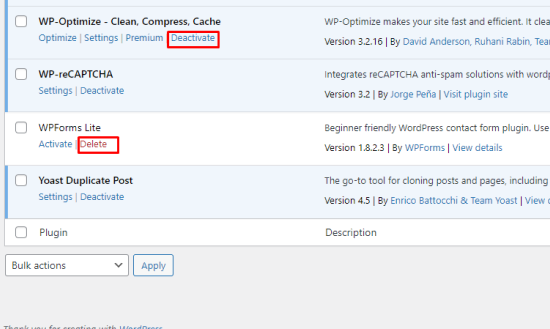
For a more comprehensive set of instructions, refer to our guide on the proper method of uninstalling a WordPress plugin.
We trust that this information has assisted you in understanding how to install WordPress plugins.
Additionally, explore our plugins category, where we discuss the finest WordPress plugins available for various purposes. Each of these articles provides step-by-step instructions on setting up individual plugins to achieve your desired goals.
If you found this article helpful, we invite you to subscribe to our YouTube Channel for more WordPress video tutorials. You can also connect with us on Facebook for additional updates and content.


